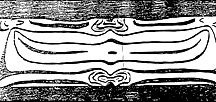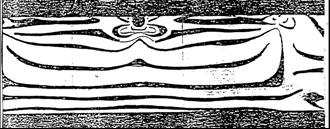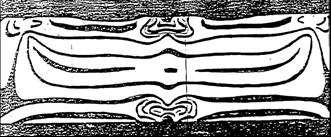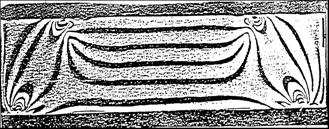

































Strength of materials – laboratory
Photoelasticity
AGH University of Science and Technology Faculty: ……………... ……………………
Kraków
Year of study ………… Group No ………
Department of Strength & Fatigue of Material & Structures
Date of exercise ………… Mark: …………
Laboratory exercises
Names: ……………………………………….
PHOTOELASTIC ANALYSES
.…………………………………..……
Task No. 1.A: Determination of the constant of the photoelastic model based on isochromatic fringe pattern observed on a beam loaded by pure bending.
1) The test stand diagram:
1
2
3
4
5
1 – source of light
2 – polarizer
3 – load frame
4 – tested specimen
5 – analyzer
DIFFUSED-LIGHT POLARISCOPE
2) The loading diagram:
2 P
P
P
σ
y
z (
)
i
y
m i
y i
h
x
z
z
g
P
P
Basic relationships:
a
a
l
σ ( ) = m ⋅ K
z y
i
(A1)
i
P
Mg( )
12 ⋅
z
Pa
T
P
(z)
σ ( ) =
⋅ y =
⋅ y
z y
i
3
i
(A2)
i
J
g
P
⋅ h
x
z
P
From eq. (1) & (2):
Pure bending
Mg
12 Pa
y
(z)
i
K =
⋅
(A3)
z
g ⋅ h 3 mi
Pa
where:
yi – coordinate of the m i order isochromatic fringe
K – constant of the photoelastic model 3) Dimensions of the specimen:
h =............... mm
g =............... mm
l =............... mm
a =............... mm
Force gage factor:
k =............... N/scale, 1/4




Strength of materials – laboratory
Photoelasticity
4) Experimental and calculation results:
Coordinate
Constant of the
Isochromatic of m
Load level
i – order
photoelastic
fringe order isochromatic
model
mi
fringe
2 P, (scale)
2 P, (N)
yi, (mm)
K, (MPa)
Kav=
Task No. 1.B: Determination of constant of the photoelastic model based on isochromatic fringe pattern observed on a compressed circular disc.
1) The loading diagram:
2) Basic relationships:
a)
Stresses in the center of disc:
2 P
σ =
6 P
;
σ = −
;
(B1)
x
y
π gD
y
π gD
P
8 P
σ −σ = σ −σ =
;
(B2)
1
2
x
y
π gD
b)
Stress-optic law:
σ −σ = m ⋅ K;
(B3)
1
2
x
c)
Model stress-optical coefficient for the circular disc (compare to eq. B2 – B3):
× g
8 P
K =
;
P
π
(B4)
gDm
where:
D, g – disk dimensions (see on the figure) m –isochromatic fringe order in the center of the disc 3) Dimensions of the disc:
D =............... mm
g =............... mm
4) Experimental and calculation results: Isochromatic
constant of the
Load level
fringe order in
photoelastic
the center of disc
model
P, (scale)
P, (N)
mi
K, (MPa)
Kav=
2/4











Strength of materials – laboratory
Photoelasticity
Task No. 2: Determination of the stress concentration factor ( kt) for the loaded by pure bending beam with single and double notch.
1) The loading diagram:
2 P
P
P
σ σ max
n
1 – distribution of the
1
nominal stress
z
2
2 – distribution of the
real stress
P
P
a
a
l
2) Considered specimens:
a) Model I
b) Model II
The single-notch beam:
The double-notch beam:
H
h
H
h 1
× g
× g
m max
m max
3) Basic relationships:
a) Stress concentration factor k t (definition): b) Maximum stresses at the notch tip σmax: σ max
k =
;
(2.1)
σ
= K ⋅ m ;
t
σ
max
max
(2.2)
n
where: m max – maximum isochromatic fringe order observed at the notch tip K – constant of the photoelastic model – assume K= K av (acc. to Task No. 1.A) c) Nominal stresses σn:
Model I:
Model II:
M
M
g
6 Pa
σ =
=
g
6 Pa
;
(2.3a)
σ =
=
;
(2.3b)
n
2
W
gh
n
2
W
gh
g
1
netto
g netto
3/4


Strength of materials – laboratory
Photoelasticity
4) Specimens’ dimensions:
l =................. mm
a =............... mm
H =............... mm
g =............... mm
h1 =............... mm
h =............... mm
5) Experimental and calculation results: Load level
Isochromatic
Stress concentration
Specimen:
fringe order at the
2 P, (scale)
2 P, (N)
factor - k
notch tip - m
t
max
Model I
Model II
6) Stress distributions in the loaded by pure bending beam determined based isochromatic pattern fingers:
Kav =................. MPa ( acc. to Task No. 1.A) a) The smooth beam:
y
σ, MPa
b) The single notch beam:
y
σ, MPa
c) The double notch beam:
y
σ, MPa
4/4
Wyszukiwarka
Podobne podstrony:
Budzik Versa wielkość karty kredytowej instrukcja EN
G2 4 PW EN wn Rys 01
Manual Acer TravelMate 2430 US EN
Ćwiczenie 01 EN DI
eci en
BVSOI 3 001 E en
A Biegus projektowanie konctrukcji stalowych wg PN EN 1993 1 1 cz 1
Flavon Active dopping EN
5817 PN EN ISO IV 2007
Pisownia ę ą en em om
NS2 lab 4 4 7 en Configure Cisco IOS IPSec using Pre Shared Keys
PN EN 1990 2004 AC Podstawy projektowania konstrukcji poprawka
EN w9 wspolpraca z siecia
EN SUPERRAIL
overview simatic controllers 04 2007 en plc
1510478 8000SRM0988 (06 2005) UK EN
HGDS EN
Heraclitus GR FR EN
więcej podobnych podstron



